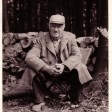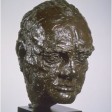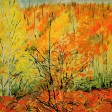The 1930s
 During the 1920s Epstein had only carved three pieces of work – the two public commissions and Marble Arms, a private representation of his relationship with Kathleen Garman. However, in 1929 he began to carve again, and spent much of the 1930s creating a series of non-commissioned works that were undertaken solely for personal satisfaction.
During the 1920s Epstein had only carved three pieces of work – the two public commissions and Marble Arms, a private representation of his relationship with Kathleen Garman. However, in 1929 he began to carve again, and spent much of the 1930s creating a series of non-commissioned works that were undertaken solely for personal satisfaction.
The first of these works, Genesis, was begun in 1929 and exhibited at the Leicester Galleries in 1931. Epstein wanted to give “expression to the profoundly elemental in motherhood, the deep down instinctive female, without the trappings and charm of what is known as feminine”. “Coarse and repellent”, “Epstein’s bad joke in stone” and “Mongolian moron that is obscene” was the verdict of the The Daily Telegraph and The Daily Express on reviewing the show.
In spite of this verdict the Leicester galleries found a buyer, the MP Alfred Blossom. Blossom bought the figure to take on a tour of the provinces to raise money for charity. This tour was astonishingly successful; in Liverpool alone nearly fifty thousand people saw the statue in a month.
The exhibition of Epstein’s new carvings became regular events throughout the decade. In 1933 he displayed Chimera, Primeval Gods and Woman Possessed. Ecce Homo followed in 1935, Consummatum Est in 1937 and Adam in 1939. All of these huge, exuberant works attracted controversy, but Ecce Home and Adam were especially reviled as insults to Christian sensibilities.
The public furore over these carvings did not, however, detract Epstein’s portrait customers. The volume of commissions he received increased, and included Emlyn Williams in 1932 and Albert Einstein in 1933.
Epstein also painted in the early 1930s. In 1932 he exhibited a series of Old Testament watercolours. The following summer he painted nearly a hundred watercolours of Epping Forest, which he also exhibited in London. Epstein was pleased with these pictures, although he recorded in his autobiography that “it was a source of annoyance to some critics that I had painted so many. This to the critic is really a sign of bad taste. Why are you so prolific? You increase and multiply. What commercialism!”.
In 1932 Epstein met Isobel Nichols, an art student who offered to model for him. Isobel moved into Hyde Park Gate with the Epstein family and in 1934 gave birth to a son, Jackie, who was Epstein’s fifth and last child. Isobel moved to Paris after Jackie’s birth. Jackie remained with Epstein and was raised by his wife Margaret. Jackie’s existence was hidden from Kathleen Garman for several years.
1935 brought more attacks on Epsteins’ previous work. The Hudson memorial was defiled by the Independent Fascist League, and the Southern Rhodesian Government purchased the former Medical Association Building in the Strand and announced their intention to remove Epstein’s statues. This announcement provoked two years of debate involving artists, museum curators and the press, but did not alter the decision. The statues were mutilated in 1937.
Epstein became involved in the anti-fascist Artist’s International Association in the late 1930s, and intended to join a group investigating conditions in Spain in 1938. This trip did not take place as he was refused a visa to travel to Spain.
When war broke out in 1939 Epstein was too old for military service. He was not an official war artist, but the War Artists’ Advisory Committee commissioned six portraits, including one of Winston Churchill.




